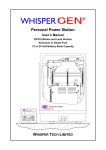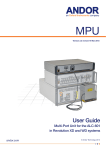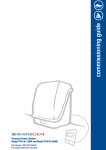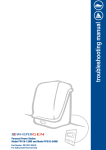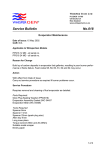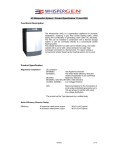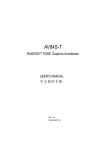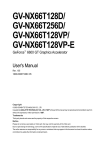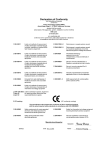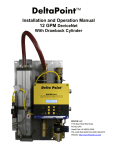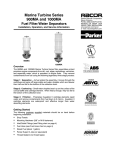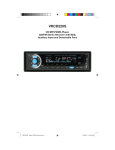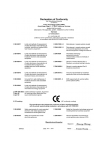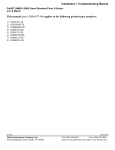Download WP-5012-002-01 DC Installation Manual - Off
Transcript
installation manual Part Number: WP-5012-002-01 Whisper Tech reserves the right to revise or change product specifications at any time. This publication describes the state of this product at the time of its publication and may not reflect the product at all times in the future. Patents granted and pending worldwide. Whisper Tech, WhisperGen, Personal Power Station, and WhisperGen Personal Power Station are registered trademarks of Whisper Tech Limited. Title Installation Manual - Models PPS16-12MD, PPS16-24MD Part No. WP 5012-002-01 Application WhisperGen PPS16-12MD Diesel fired 12 V DC output Marine WhisperGen PPS16-24MD Diesel fired 24 V DC output Marine WhisperGen is designed and manufactured by Whisper Tech 224 Armagh St P O Box 13-705 Christchurch New Zealand www.whispergen.com Copyright ©2005 Whisper Tech Limited All Rights Reserved Printed in New Zealand Conditions of use Read this manual completely before installing or operating the WhisperGen. The WhisperGen must be commissioned only by an authorised WhisperGen representative. Whisper Tech accepts no liability for personal injury or property damage resulting from incorrect or unauthorised installation, commissioning and servicing of the WhisperGen. Unapproved installations may be dangerous, result in poor performance and void any WhisperGen warranty. Along with any warnings, instructions and procedures in this manual, the user should also observe any such other common sense procedures generally applicable to equipment of this type. Failure by the user to comply with any warnings, instructions, procedures, or any such other common sense procedures may result in injury, equipment damage, property damage or poor performance of the WhisperGen. The major hazards involved with operating the WhisperGen include explosion, fire, carbon monoxide fumes and electrical shock. These hazards can be avoided if the user adheres to the procedures in this manual and exercises all due care. Whisper Tech accepts no liability for direct, indirect, incidental, special, or consequential damages resulting from failure by the user, installer or service technician to follow any warnings, instructions and procedures in this manual, or any such other common sense procedures generally applicable to equipment of this type. The foregoing limitation extends to damages to person or property caused by the WhisperGen, or damages resulting from the inability to use the WhisperGen, including loss of profits, loss of products, loss of power supply, the cost of arranging an alternative power supply and loss of time, whether incurred by the user, its employees, the installer, a service technician or any third party. Whisper Tech reserves the right to change the specifications of its products, or the information in this manual, without necessarily notifying its users. Variations in installation and operating conditions may affect the WhisperGen’s performance. Whisper Tech has no control over each installation's unique operating environment. Hence, Whisper Tech makes no representations or warranties concerning the performance of the WhisperGen under the actual operating conditions prevailing at the installation. All operating parameters for each application should be validated by a technical expert of the user’s choosing. Whisper Tech has made every effort to explain all installation, commissioning, operating, maintenance, troubleshooting procedures, warnings and safety precautions as clearly and completely as possible. However, due to the range of operating environments it is not possible to anticipate every issue that may arise. Therefore, Whisper Tech is not able to guarantee that this manual will address every issue that may arise. This manual is intended to provide general guidance. For specific guidance and technical support, contact your authorised WhisperGen supplier. Information in this manual shall not be deemed a warranty, representation or guarantee. For warranty provisions applicable to your WhisperGen, please refer to the warranty provided by the supplier of your WhisperGen. Unless otherwise noted, reference to brand names, product names or trademarks constitute the intellectual property of the owner thereof. Subject to your right to use the WhisperGen, Whisper Tech does not convey any right, title or interest in its intellectual property, including, without limitation, its patents, copyrights and know-how. No part of this manual may be reproduced or transmitted in any form or by any means without the express written permission of Whisper Tech. Every effort has been made to ensure the accuracy of this document, however it may contain technical inaccuracies or typographical errors. Whisper Tech assumes no responsibility for and disclaims all liability of such inaccuracies, errors, or omissions in this publication. Use of the WhisperGen shall constitute your acceptance of the conditions above Contents Introduction and safety information................................................................................................................................ 1 Overview of the WhisperGen ................................................................................................................................... 1 Purpose of this manual ............................................................................................................................................ 1 Importance of correct installation ............................................................................................................................. 2 Symbols in this manual ............................................................................................................................................ 2 Emergency procedures ............................................................................................................................................ 2 Normal operation ..................................................................................................................................................... 3 Identification of main components............................................................................................................................ 3 Labels ...................................................................................................................................................................... 4 Compliance information ........................................................................................................................................... 5 Design and plan your installation.................................................................................................................................... 6 Introduction .............................................................................................................................................................. 6 Equipment supplied with the WhisperGen ............................................................................................................... 6 Installation kits (optional).......................................................................................................................................... 7 Select a site for the WhisperGen ............................................................................................................................. 8 Fuel system.............................................................................................................................................................. 9 Primary cooling system/boat heating system ......................................................................................................... 12 Secondary cooling system/seawater heat dump circuit ......................................................................................... 18 Exhaust & condensate drain .................................................................................................................................. 21 Fresh water flushing............................................................................................................................................... 23 Battery bank........................................................................................................................................................... 24 Install the WhisperGen ................................................................................................................................................... 25 Unpack the WhisperGen........................................................................................................................................ 25 Dispose of the packaging....................................................................................................................................... 25 Remove and re-fit the enclosure ............................................................................................................................ 25 Lift the WhisperGen ............................................................................................................................................... 26 Attach the exhaust heat exchanger........................................................................................................................ 26 Fix the WhisperGen into position ........................................................................................................................... 27 Connect fuel and plumbing fittings ......................................................................................................................... 28 Install the control panel .......................................................................................................................................... 29 Connect the electrical power and control wiring..................................................................................................... 30 Prepare for commissioning............................................................................................................................................ 33 To operate the control panel .................................................................................................................................. 33 Fill and bleed the primary coolant system.............................................................................................................. 34 Bleed the secondary cooling system...................................................................................................................... 36 Bleed the fuel system............................................................................................................................................. 37 Appendices...................................................................................................................................................................... 38 Transporting by land or air ..................................................................................................................................... 38 Technical specification........................................................................................................................................... 38 WhisperGen DC Marine Installation checklist ........................................................................................................ 41 Introduction and safety information Overview of the WhisperGen Introduction and safety information Overview of the WhisperGen The WhisperGen is a combined heat and power generating system providing efficient, low maintenance generation of DC electric power. The WhisperGen uses a four-cylinder double-acting external combustion (Stirling cycle) engine. Interconnected cylinders are pressurised with nitrogen gas and sealed. The gas is heated at the top of the cylinders by a continuous combustion burner and cooled at the bottom by coolant circulation. The resulting change in pressure causes pistons inside the cylinders to move up and down. A unique 'wobble yoke' mechanism ensures the correct phasing of the pistons and converts their linear motion to rotary motion to drive a DC electrical generator which can be used to charge a battery bank. Key: 1. 2. 3. 4. 5. 6. 7. 8. 9. 9 WhisperGen Battery bank DC/AC inverter Standard domestic appliances Hot water for domestic use Space heating Excess heat removal 12 or 24 V equipment Cool exhaust vent 6 5 4 8 1 3 2 7 The heat generated by the burner is removed by coolant circulating through the engine cavities. The coolant used in the WhisperGen is circulated by pump to heat hot water cylinders and to provide cabin heating. A microcomputer controls all the WhisperGen functions and displays real time operating conditions on an LCD control panel. The WhisperGen DC output goes to a battery bank, which provides an electrical buffer for the varying loads required. When the battery bank charge is low the WhisperGen can be set to automatically start and bring the charge back up to a preset level. Once the battery bank is charged the WhisperGen can be set to either stop, or to continue operating to provide heat energy. DC electrical items can be run directly off the battery bank, and AC appliances via a DC/AC inverter. Purpose of this manual This manual details the correct installation procedure for the: WhisperGen PPS16-12MD diesel-fired generator with 12 V DC output WhisperGen PPS16-24MD diesel-fired generator with 24 V DC output and their associated systems, into recreational craft. The WhisperGen must not be used in any other capacity. Use the Installation checklist (on page 41) to guide you through installation. A separate User Manual is provided for the general operation and maintenance of the WhisperGen. 1 Introduction and safety information Importance of correct installation Importance of correct installation The WhisperGen is technically advanced equipment that must be installed correctly for reliable operation. It is recommended that installation be undertaken by a suitably qualified person. This manual outlines the correct way to install the WhisperGen. After the WhisperGen is installed, an authorised WhisperGen representative must do the final system checks, a first start, and commissioning. Failure to use an authorised WhisperGen representative for commissioning may result in the warranty being void. Please keep this manual in a secure place near the WhisperGen. Symbols in this manual Symbols are used in this manual to highlight information that is critical to the safety of people and equipment, and to the safe and correct operation of the WhisperGen. An extreme hazard which may result in death or injury if proper precautions are not taken. A reminder of safety practices or unsafe practices which could result in personal injury or damage to associated equipment. A reminder of safety practices or unsafe practices which could result in damage to the WhisperGen and/or void the warranty. Important information essential to the installation and operation of the WhisperGen. Emergency procedures Stopping the WhisperGen To stop the WhisperGen in an emergency: Push and hold the Stop button on the controller until it beeps, and/or Use the emergency fuel isolation valve on the front panel of the WhisperGen to isolate the fuel supply to the burner, and/or Shut off the fuel isolation valve at the fuel tank outlet. If fuel vapours are detected in close proximity to the WhisperGen, stop the WhisperGen immediately and ventilate the area. Isolating the WhisperGen from the battery bank To isolate the WhisperGen from the battery bank: Open the circuit breaker and remove the in-line fuse from the voltage sense wires. Isolating the WhisperGen from the batteries while the WhisperGen is running will result in engine damage and void the warranty. In the event of fire If a fire occurs: Use a CO2 or Dry Powder fire extinguisher. DO NOT USE WATER! Use of water on diesel or electrical fires can result in explosion, burns, and electrical shock. 2 Introduction and safety information Normal operation Normal operation Only run the WhisperGen after it has been commissioned by an approved WhisperGen agent. Attempts to run the WhisperGen before commissioning may damage the engine and void the warranty. Under normal operating conditions, you should run the WhisperGen with the main enclosure (cover) firmly in place. Do not run the WhisperGen for more than five minutes with the cover removed. Identification of main components The main components of the WhisperGen are identified in the diagram below. They are referred to throughout the manual. Key: 1. 2. 3. 4. 5. 6. 7. 8. 9. 10. Fuel evaporator assembly Air intake Burner assembly Exhaust heat exchanger Lifting lug Terminal block Electronics enclosure Main enclosure (cover) Fuel valve Control panel 1 4 3 2 5 2 7 6 Personal Power Station 8 R R 10 STA ND B Y STA RTING R UN N IN G STOPPING START FA ULT A UTOC HA R GE EXT C ON TROL H EAT M AN A GE STOP 3 ON FUEL OFF 9 Introduction and safety information Labels Labels The WhisperGen is supplied with caution and warning labels affixed to it. The labels and their locations are shown below. Please ensure that: Labels are not removed. Installers and operators understand and comply with the instructions on the labels. 1. Diesel Fuel Only Diesel fuel only, hot temperatures inside. 2. Serial Number Plate 3. No Lift Do not lift the WhisperGen from this point. DIESEL NO LIFT 4. Warning - General 5. Nitrogen Pressure Nitrogen pressure vessel and pressure settings. 4 6. Warning Primary Coolant Primary coolant circuit additives. Introduction and safety information Compliance information Compliance information Responsibility for compliance European CE mark and installation standards for recreational craft installations It is the responsibility of the person(s) installing the WhisperGen and its systems to ensure that it is installed in compliance with all laws, standards, and regulations that apply in the country where the WhisperGen is installed. The installer must determine what laws and regulations apply. The WhisperGen is CE marked for applications where it is installed in recreational craft. This means that in such an installation the WhisperGen complies with the Essential Health and Safety Requirements of the relevant European Commission Directives, which are: Machinery Directive 98/37/EC. Electro Magnetic Compatibility Directive 2004/108/EC. Pressure Equipment Directive 97/23/EC Waste Packaging Directive 94/62/EC. The installation of the WhisperGen must comply with the Recreational Craft Directive 94/25/EC and the Amending Directive 2003/44/EC. This manual provides information to help the installer comply with the installation requirements of the Recreational Craft Directives. Although the WhisperGen itself is not included in the scope of these Directives, it has been developed so that it can be installed in accordance with them. The Recreational Craft Directive harmonised standards relevant to the installation of the WhisperGen are: ISO 7840:2004 Small craft – Fire resistant fuel hoses ISO 9093-1:1994 Small craft – Seacocks and through hull fittings, metallic ISO 9093-2:2002 Small craft – Seacocks and through hull fittings, non metallic ISO 9094-1:2003 Small craft – Fire protection for a hull up to 15 m in length ISO 10088:2001 Small craft – Permanently installed fuel systems and fixed fuel tanks ISO 10133:2000 Small craft – Electrical systems – Extra low voltage DC installations ISO 10240:1995 Small craft – Owners manual ISO 16147: 2002 Small craft – Inboard diesel engines – engine mounted fuel & electrical components Explosive environments The WhisperGen is not suitable for installation in spaces or compartments that require ignition-protected equipment. 5 Design and plan your installation Introduction Design and plan your installation Introduction The WhisperGen is at the heart of a recreational marine power generation and heating system that varies from vessel to vessel, depending on customer requirements and the vessel configuration. The equipment supplied (on page 6) with the WhisperGen, and the optional installation kits (on page 7), comprise only part of the overall system. Safe and effective operation of the WhisperGen requires that all parts of the system are correctly designed and installed. This section has essential design and planning information on: The equipment supplied with the WhisperGen. The optional installation kit. Selecting a site for the WhisperGen. Designing and installing the fuel, cooling, exhaust, condensate drain, freshwater flushing, and battery systems. Please read all the guidelines and prepare a detailed design and installation plan before commencing any installation work. Equipment supplied with the WhisperGen The following equipment is supplied with every WhisperGen. 1. WhisperGen Model PPS16 - either 12 V or 24 V 2. Control panel and mounting clamp - either 12 V or 24 V 3. Control panel cable - 10 metres 4. Fuel pump: 12 V - Mikuni ESP12-MY11A or 24 V - Mikuni ESP12-MY12A 5. Current shunt - 500 A 50 m V 6. Battery bank temperature sensor 7. Fuse and inline holder - 2 A 8. Spare fuses: Blade type 3, 5, 10, 15 A Cartridge type 32 A 9. Installation Manual and Checklist 10. WhisperGen fixing template 11. User Manual 6 Design and plan your installation Installation kits (optional) Installation kits (optional) The optional installation kits contain hoses, hose fittings, pumps, valves, electrical components, and other parts compatible with the WhisperGen that will be required in all new installations and in some retro-fit installations. Contact your WhisperGen agent for current details of the kit relevant to your installation. The part numbers are: Heating option: Kits required: Part number: Potable water Base kit, plus heating and up to 12 V supplementary kit, or 5.5 kW space heating, short heating circuit and/or 24 V supplementary kit. new installation WP-5011-007-00 Additional space heating (over 5.5 kW), large heating circuit and/or existing installation WP-5011-010-00 Space heating supplementary kit. (Also requires purchase of Base kit plus 12 or 24 V supplementary kit.) WP-5011-008-00 WP-5011-009-00 See Primary cooling system/boat heating system (on page 12) for descriptions of the different heating options. 7 Design and plan your installation Select a site for the WhisperGen Select a site for the WhisperGen Requirements The WhisperGen must be mounted on a surface that is: Clean. Dry. Level. Flat. Strong and rigid enough for the expected loadings. Impervious to diesel fuel and water. The WhisperGen should be located: In an area with an ambient temperature range of -10°C to 40°C. In an area separated from living or accommodation spaces. If installation in a living space is necessary, a sealed compartment should be used with adequate ventilation from outside the living space. Where there is adequate ventilation and supply of air for combustion. Away from magnetic compass / navigational devices. For installations near such devices, the devices must be compensated for any magnetic or electrical influences. With minimum clearances as shown. Minimum clearances Key: 150 mm 1. Minimum 150 mm for cover removal and removal of FID 2. Minimum 300 mm for service access 3. Allow at least 100 mm between the back of the WhisperGen and the hull or wall for pipework and fittings 1 650 300 mm 2 50 500 450 50 100 3 The air intake is located underneath the enclosure base and must remain unrestricted at all times. If the WhisperGen is located in an enclosed area, a minimum 20 cm2 opening must be provided to allow fresh air to the WhisperGen. Use the WhisperGen fixing template to correctly mark the fixing points on the floor. The control panel needs a wall that is clean and dry with access behind it so that it can be mounted. The wall should be between 1.5 and 15 mm thick. 8 Design and plan your installation Fuel system Fuel system Overview of the fuel system Overview of the fuel system The fuel system for the WhisperGen must consist of: A fuel tank and fuel pick-up, An isolation valve, A filter, A water separator (this may be combined with the filter), A fuel pump (supplied with the WhisperGen), and Suitable piping and fittings. Correct flow and pressure of fuel to the WhisperGen is essential for its operation, and can be affected by the diameter and length of the piping used, and by the location of the components in the line. Meeting the component specifications and design guidelines below will result in a safe and effective fuel system. Component specifications Fuel type: Automotive diesel (BS2869:1998 burner fuel class C2) Fuel filter and water separator: Bowl type combined filter/water separator Max. 10 micron element Min. 1 L/hr flow rate 200 kPa max. pressure Connection to suit fuel line (3.2 mm ID) Fuel line - metallic tube: Seamless, annealed copper, stainless steel, or equivalent 3.2 mm ID Fuel line - flexible hose: Fire, fuel and chemical resistant ISO 7840 type A1 or A2, UL 1114, or SAE J1527 hose 3.2 mm ID Hose clips for fuel hose (do not use spring clamps): Stainless steel 8 mm nominal width Isolation valve: Appropriate fuel standard isolation valve with fittings to suit line diameters. eneral Requirements General requirements The fuel system must be permanently installed, and all component parts, with the exception of small connectors and fittings, must be supported individually. All fuel system components must be installed above the anticipated bilge water level. The fuel system needs an ambient temperature range of -10°C to 80°C. The WhisperGen requires a dedicated fuel supply directly from the main fuel tanks. Do not tap off existing fuel lines to supply the WhisperGen. All fuel system components, individually or as an installed system, must be able to withstand a 2.5 minute fire test in accordance with the Recreational Craft Directive and its harmonised standards. See Compliance information. Sy stem Lay out 9 Design and plan your installation Fuel system Fuel system layout A correctly laid out fuel system will ensure: A free flow of fuel (i.e. gravity fed) at the rate of 1 litre / hour to the fuel filter / separator under all boat operating conditions. The fuel pump is no more than 300 mm from the filter. The WhisperGen is positioned no more than 6 m in total, and 1.25 m vertically, above the fuel pump. Draw a scale diagram of your fuel system layout and ensure it meets these requirements before starting your installation. The layout sequence starting from the fuel tank is: 1. Fuel tank and pick up. 2. Fuel isolation valve. Max 200 mm from the fuel tank. 3. Day tank and integrated lifting pump (only required if the fuel tank pickup is lower than the fuel filter/separator). 4. Fuel filter / separator. Minimum free flow at filter of 1 litre per hour. Maximum distance from the fuel tank is 5 m if using a 10 mm ID line. Greater lengths can be achieved using larger diameter lines. 5. Fuel pump. Maximum distance from the filter is 300 mm. ID of the line must be 3.2 mm (1/8”). 6. WhisperGen. Maximum length of line from the pump to the WhisperGen is 6 m. Maximum rise from the pump to the WhisperGen is 1.25 m. ID of the line must be 3.2 mm (1/8”). Fuel tank and pick-up The fuel tank must be positioned so that the fuel pick-up (either from the bottom of the tank, or via stand pipe and siphon) is not lower than the fuel filter / separator i.e. there must be a free flow of fuel to the filter / separator. If the bottom of the tank is positioned below the filter / separator, then a raised day tank with integral lifting pump and demand or float valve is required. The fuel pick up in the tank(s) must be installed to ensure fuel availability at all angles of heel. The isolation valve must be positioned at a maximum 200 mm from the tank. Fuel pump The fuel pump should be: Mounted between 45° and vertical. Supported independent of the fuel lines. Isolated from the vessel structure by rubber mounts. Mounted away from the battery bank. Oriented in the direction of the arrow on the pump. uel Sy stem connections 10 Design and plan your installation Fuel system connections Fuel system Connections or joints between rigid lines must be made with screwed, compression, cone, brazed or flanged joints. All flexible fuel lines must be secured to component studs with a metal hose clamp, or a permanent fitting such as a swaged sleeve or threaded insert. All rigid fuel lines must be supported at 300 mm spacings and within 100 mm of connection to a flexible line. Do not use clamps that rely solely on spring tension. Adequate precautions must be taken to prevent accidental spillage or discharge of pollutants, such as fuel and anti-freeze, into the bilge, or overboard. All work carried out and components used as part of the WhisperGen fuel installation must comply with the Recreational Craft Directive (on page 5) and its harmonised standards. 11 Design and plan your installation Primary cooling system/boat heating system Primary cooling system/boat heating system Overview of the entire coolant system Overview of the entire coolant system The engine coolant system can be used to provide cabin heating and potable water heating for the boat. An electrical element (clamp element) is built into the WhisperGen internal coolant circuit to provide extra heating capability if the battery bank is charged and the WhisperGen is being operated for heating purposes. This element is operated by the microprocessor. All internal coolant piping on the WhisperGen is complete, with both primary and secondary coolant circuit inlet and outlet connections located at the back of the machine. Key: 1. 2. 3. 4. 5. 6. 7. 8. 9. Exhaust heat exchanger Core engine Clamp element heater Generator housing Marine heat exchanger Secondary cooling in Secondary cooling out Primary coolant in Primary coolant out 5 2 6 1 7 4 8 3 9 verview of the primary coolant circuit Overview of the primary coolant circuit The primary coolant circuit is a self-contained, fully pumped circuit. It can be sealed or sealed and pressurised. Open-vented systems are not recommended. It uses treated coolant to provide corrosion protection for critical engine components. Coolant is pumped from a header tank to the WhisperGen where it passes through the primary side of the marine heat exchanger to remove any excess heat. The coolant then passes through the clamp element heater, generator housing and core engine, before passing through the exhaust heat exchanger. Now at a state of highest temperature it exits the WhisperGen and may be used to: Option 1: Heat just the potable water supply. Option 2: Heat the potable water supply and up to 5.5 kW of space heating. Option 3: Heat the potable water supply and, through an additional heat exchanger, provide supplementary heat to a separate space heating circuit greater than 5.5 kW. Configuration requirements for each of the three heating options follow. 12 Design and plan your installation Primary cooling system/boat heating system Option 1, 2, 3 (DC Marine) Option 1: Potable water heating only When the WhisperGen is in Battery Charging mode it can provide sufficient thermal energy to heat a large quantity of potable hot water. The WhisperGen can be connected to a thermostat in the calorifier or hot water cylinder so it will start and stop on command from this thermostat. Key: 1. 2. 3. 4. 5. 6. Header tank Pressure relief valve (100 kPa) Stopcock Filter (min. 100 micron) Coolant pump Water heater - Calorifier 1 3 4 5 3 2 Option 2: Potable water heating and up to 5.5 kW space heating 6 The WhisperGen primary coolant circuit can directly supply hot water for space heating of up to 5.5 kW, provided the total length of the circuit is less than 15 m. In this configuration do not use a thermostat to control WhisperGen operation as it would result in frequent stop/start cycling of the unit leading to excessive cabin heating temperature fluctuation. Instead, use thermostatic valves or switched fans on the boat heating system radiators. Key: 1. 2. 3. 4. 5. 6. 7. 8. Header tank Pressure relief valve (100 kPa) Stopcock Filter (min. 100 micron) Coolant pump Water heater - Calorifier Radiators, air/water heater Room thermostat 1 8 3 4 5 6 7 2 3 13 Design and plan your installation Primary cooling system/boat heating system Option 3: Over 5.5 kW heating requirement For larger heating systems and extended cold climate operation, it is strongly recommended that a separate purpose designed heating system be installed. Option 3 is also recommended for existing heating systems (i.e., not new installations). The heating system should be isolated from the WhisperGen by the use of a suitable heat exchanger (available from your WhisperGen agent in the optional installation kit (on page 7)). The WhisperGen will act as an auxiliary heater when it is charging the batteries thus augmenting the main water heater. The heating unit and pump in the separate heating system can be controlled by a room thermostat. In the warmer months when heating is not required, the system can be left in standby mode and, because it is isolated from the WhisperGen, will not affect the WhisperGen's operation. Key: 1. 2. 3. 4. 5. 6. Header tank Pressure relief valve (100 kPa) Stopcock Filter (min. 100 micron) Coolant pump Water heater - Calorifier 7. 8. 9. 10. 11. 12. Heat exchanger Diesel water heater Radiators, air/water heater Expansion or header tank Pump (if not fitted to heater) Thermostat 1 10 12 7 11 3 2 4 5 6 3 8 14 9 Design and plan your installation Primary cooling system/boat heating system omponent Specifications Component specifications The components listed apply to Options 1 & 2 above. Most components are available in the optional installation kits (on page 7). Coolant pump: 12 V DC for 12 V models 24 V DC for 24 V models Max. power 50 W Max. system pressure 100 kPa 20 - 30 L/min capability. Min. system flow rate of 6 - 11 L/min Hose/pipe fittings (do not use brass or copper): 3/4" BSPT male x 3/4" hose or pipe fittings x 2 Nylon or stainless steel, rated for continuous operation at 125ºC/200 kPa. Flexible hose or pipework: Domestic hot water/central heating system type pipe or reinforced flexible hose. Rated for continuous operation at 125ºC/200 kPa, min. 19 mm ID. Hose pipe clips: Marine grade stainless steel. Header tank (sealed with pressure cap): Rated for continuous operation at 125ºC/200 kPa min. Volume to be at least 5% of the volume of liquid in the circuit. Minimum 3 litre operating capacity. Coolant: Clean distilled water and high quality marine grade corrosion inhibitor, suitable for use with aluminium and any other metals that may be encountered in the system (i.e. steel, copper). If freezing conditions are expected, a glycol based marine grade anti-freeze is to be used. All additives must be pre-mixed. Do not connect the boat's main engine cooling system to the same circuit as the WhisperGen, as cast iron contaminants may damage the WhisperGen. If the coolant system is used to heat the vessel potable water system, a compatible non-toxic corrosion inhibitor (and antifreeze if required) must be used. Relief valve and discharge pipe: Certified 100 kPa relief valve Discharge pipe that is no less a bore than the bore of the connection to the valve. Hot water cylinder/calorifier: Min. capacity 40 litres. Coil length 1.0 m per 20 L/capacity up to a maximum of 10 m, min. 13 mm ID. nk Header tank In a typical installation a header tank must be installed at the highest point in the primary coolant system, directly upstream of the circulation pump. The header tank provides a point for filling and bleeding the system, and allows space for thermal expansion. If use of a header tank is not possible, use a pressurised accumulator system. 15 Design and plan your installation Primary cooling system/boat heating system Relief Valve, primary coolant pump, etc Relief valve The pressure relief valve must be fitted directly to the WhisperGen primary coolant outlet connection. Make sure there is no intervening valve, or restriction between the outlet connection and the relief valve. The discharge pipe must be fitted and located so that: The discharge of water or steam from the valve is visible. Water or steam will not discharge onto the occupants of the vessel, or cause damage to the vessel or electrical components and wiring. Primary coolant pump The coolant pump must be sized to provide sufficient flow rate and pressure to overcome the pressure drop for the complete coolant/heating system. Install the coolant pump immediately upstream of the WhisperGen with suction connected directly to the header tank. Keep the distance between the header tank and the pump suction to a minimum. Hot water cylinder/calorifier Cabin heating Interconnecting pipework If the hot water cylinder thermostat is used to start and stop the WhisperGen, then it must be set to 5°C below the WhisperGen temperature setpoint. Cabin heating can be by radiator or fan heater. All interconnecting pipework must be in accordance with all local laws and regulations. The minimum recommended pipe size is 19 mm ID diameter. Install air bleed valves at any high points in the system and a drain valve at the lowest point. By-pass circuit If the room heating or calorifier heating flow is controlled by thermostatic valves, a by-pass circuit must be installed to allow coolant to circulate when heating is not required. If the water flow cannot be maintained during engine shutdown, the WhisperGen can overheat. To overcome this use one of the following options: Install a by-pass valve over the calorifier valve. This will ensure that the water flow is maintained over the cylinder and that sufficient water volume is available. Install a by-pass circuit in the cabin heating heating system. This will ensure that water flow is maintained. Operational specifications Flow rate (min. - max.). This is the flow rate requirement for the complete, installed system. 6 - 11 L/min Pressure drop across the WhisperGen at 20°C temperature difference. 40 kPa at 11 L/min Pressure drop across the WhisperGen at 20°C temperature difference. 12 kPa at 6 L/min Max. system pressure. 100 kPa Water volume inside WhisperGen. 2L Max. electrical load. 50 Watts 16 Design and plan your installation Primary cooling system/boat heating system Warning and caution (DC Marine Only) Warnings and cautions If the coolant system is connected to the vessel potable water system, a compatible non-toxic corrosion inhibitor must be used. Do not connect the boat's main engine cooling system to the same circuit as the WhisperGen, as cast iron contaminants may damage the WhisperGen. Use only the specified coolant. Use of incorrect coolant will result in corrosion of the WhisperGen and will void the warranty. Always refer to manufacturer's instructions for corrosion inhibitors and antifreeze solutions. 17 Design and plan your installation Secondary cooling system/seawater heat dump circuit Secondary cooling system/seawater heat dump circuit Overview of the entire coolant system The engine coolant system can be used to provide cabin heating and potable water heating for the boat. An electrical element (clamp element) is built into the WhisperGen internal coolant circuit to provide extra heating capability if the battery bank is charged and the WhisperGen is being operated for heating purposes. This element is operated by the microprocessor. All internal coolant piping on the WhisperGen is complete, with both primary and secondary coolant circuit inlet and outlet connections located at the back of the machine. Key: 1. 2. 3. 4. 5. 6. 7. 8. 9. Exhaust heat exchanger Core engine Clamp element heater Generator housing Marine heat exchanger Secondary cooling in Secondary cooling out Primary coolant in Primary coolant out 5 2 6 1 7 4 8 9 3 Overview of the secondary cooling circuit The secondary system is an open, pumped, total loss system. Sea water is circulated through the secondary side of the integrated marine heat exchanger before being dumped overboard. This removes any surplus heat from the WhisperGen primary coolant circuit. The pump speed is determined by the engine temperature, and regulated automatically by the WhisperGen via a variable speed output. Key: 1. 2. 3. 4. 5. Inlet seacock One way valve (if required) Strainer / filter Secondary cooling pump (self-priming) Outlet seacock 3 4 2 1 5 18 Design and plan your installation Component specifications Secondary cooling system/seawater heat dump circuit Secondary cooling pump: 12 V DC for 12 V models. 24 V DC for 24 V models. See further requirements below. Hose fittings: 3/4 BSPT male x 3/4 hose tail fitting x 2. Flexible hose: 19 mm ID, high quality, marine grade. Hose clips: Marine grade stainless steel, either permanently crimped or double hose clamps. Seacocks and through-hull fittings: High quality, marine grade to suit the vessel. Other components: One way valve, marine grade, to suit hose size (required if sharing a raw water supply with other equipment). Strainer / filter, marine grade, to suit hose size. Secondary cooling pump The secondary cooling pump should: Be suitable for use with sea water. Provide the specified flow rate (See Operational specifications below). Be self-priming. Be compatible with Pulse Width Modulation control. The final pump size is determined by the pressure drop within the system. This is a combination of pressure drop through the various system components, pipe length, pipe diameter and vertical rise. Contact your WhisperGen agent or a pump specialist to correctly size the pump for the particular vessel installation. Do not oversize the pump as it would increase the rate of flooding if a leak develops in the secondary coolant circuit. The pump should be located above the waterline, in a position immediately upstream of the WhisperGen. Through-hull fittings Through-hull fittings and seacocks should be installed prior to WhisperGen installation by a tradesman suitably experienced to carry out such work. All through-hull fittings must be installed in accordance with ISO 9093-1 and fitted with seacocks. The inlet fittings should be positioned to ensure: The inlet remains below the water line at all times. The inlet is not subject to turbulence when the vessel is under way. Fittings that extend through the hull must not affect the integrity of the hull. The discharge for the secondary coolant system should be located below the waterline, a minimum of 2.0 m from the inlet. It is a good idea to have the inlet and outlet on opposite sides of the keel. This will avoid hot water 'pooling' when moored in quiet waterways. 19 Design and plan your installation Secondary cooling system/seawater heat dump circuit Pipelines and in-line fittings All pipelines and fittings must be installed to minimise pressure drop and prevent airlocks. If the secondary cooling circuit is to be connected to a shared raw water supply, then a one-way valve should be fitted on the inlet side. This will ensure that the WhisperGen secondary system always has water in it. The pump must be protected from the induction of debris by way of inline filter or strainer fitted between the pump and the one way valve. All connections must be fitted with two hose clamps. Operating specifications Warnings and cautions Flow rate (min. - max.) Pressure drop across heat exchanger Max. allowable pressure inside heat exchanger Pump max. electrical load 6 - 11 l/m 10 kPa @ 10 l/m 100 kPa 50 Watts Be careful when installing pipes and fittings. If the seawater coolant pipes and/or fittings fail, the vessel could flood. If possible, the WhisperGen should have its own inlet and outlet for the secondary coolant system. 20 Design and plan your installation Exhaust & condensate drain Exhaust & condensate drain Overview of the exhaust Component specification WhisperGen requires a dedicated, low back pressure, exhaust system that carries exhaust gases safely overboard whilst avoiding the build-up of condensates at low points in the system. Exhaust tubing: 32 mm ID minimum marine quality exhaust tubing. Exhaust outlet cowling: As necessary to protect the exhaust outlet from wind and wave action. Condensate drain tubing and clips: Good quality, clear, chemical resistant, reinforced, 13 mm diameter. All materials used in the exhaust system must be marine grade, resistant to salt water, oil and combustion products, and must maintain integrity at temperatures up to 200°C. Exhaust route The exhaust system must be continuous and sealed from the WhisperGen to the point of discharge: Do not connect the WhisperGen exhaust system into other exhaust systems. Do not connect other discharges into the exhaust. All parts of the exhaust system must be accessible for inspection. Piping and components must be supported to minimise the risk of failure from vibration, shock, expansion and contraction. The exhaust system must not pass through accommodation or living spaces. Exhaust outlet The exhaust outlet must not be positioned within 500 mm of a refuelling fitting or tank vent. The exhaust outlet must ensure that: All combustion products are ducted to the outside. Re-entry of combustion products through openings into accommodation spaces is minimised. The exhaust is protected from wind gusts, back drafts, and water by a weather cowling. The exhaust is not able to be submerged at any time, not even momentarily, including when the vessel is being reversed. An external outlet to stern is preferable on a mono sail or motor launch. The outlet can be between hulls on a catamaran. Bend in pipe to prevent backwash from exhaust outlet WhisperGen Exhaust outlet with suitable cowling Transom 21 Design and plan your installation Exhaust & condensate drain Back pressure (length and diameter design) The system must be designed to minimise back-pressure. The minimum exhaust pipe size is 32 mm ID. If the exhaust exceeds 4 m in length, the back-pressure of the exhaust should be measured with a manometer to ensure that it is less than 7 mm H20 at 70°C. Consult your WhisperGen representative if you are unsure. To minimise back pressure, keep the number of bends to a minimum and do not use corrugated hose. Do not install dampers or shut off valves in the exhaust. Condensate drain points Condensate forms in the exhaust heat exchanger and down the entire length of the exhaust pipe under all operating conditions - and must be removed. The WhisperGen incorporates a condensate drain point, however any other low points in the exhaust system must also incorporate drain points. Low points in the exhaust may occur when the boat is on a heel, and these must be planned for and drains installed accordingly. Where possible, a 10° fallback to the WhisperGen and other condensate outlets is desirable. Each condensate drain must prevent exhaust gases leaking into the vessel. Where the drain is into an open waste water system or other collection / disposal point, a water seal type air trap must be used as shown in the diagram below. Each condensate drain tube must contain a water seal air trap to prevent exhaust gases leaking into the vessel. The tube must contain a 150 mm diameter loop with a water seal. Operational specifications Warnings and cautions Max. temperature under normal operating conditions 90ºC Max. temperature under an extreme fault condition 150ºC Back pressure (max.) 7 mm H²O at 70ºC Exhaust fumes can cause illness and death. Make sure that exhaust gases are vented outside enclosed areas at all times. Avoid condensate contact with skin and eyes. Wear protective clothing when dealing with condensate. 22 Design and plan your installation Fresh water flushing Fresh water flushing Overview of fresh water flushing system The exhaust heat exchanger is flushed with fresh water for 10 seconds each time it is started and every 10 hours during operation to prevent soluble deposit build-up from the fuel. The fresh water is normally plumbed from the domestic pressurised fresh water supply to the fresh water connection on the back of the WhisperGen. The flushed water drains into the condensate tank, and exits the WhisperGen via the condensate drain. Component specifications Connection to back of WhisperGen: 3/4" BSP female connection required (WhisperGen has a 3/4" BSP male connection). Isolation valve Operational specifications Warnings and cautions An isolation valve must be fitted between the supply and the WhisperGen. The isolation valve must be left open when the WhisperGen is operating and closed in the case of emergency or servicing. Discharge flow rate (nominal) 1 L/hr Flow rate (max. instantaneous when flushing) 25 ml/sec (max. 10 sec) Discharge temperature max. 90°C Supply pressure 150 to 600 kPa (20 to 90 psi) For the fresh water flushing, avoid using hard water if possible. The use of water with high calcium or magnesium concentrations can result in nozzle blockage which will mean regular cleaning. 23 Design and plan your installation Battery bank Battery bank Overview of the battery bank The WhisperGen DC output goes to the battery bank via the current shunt (-ve) and the distribution board (+ve). The battery bank provides an electrical buffer for the varying loads required. When planning the location and installation of the battery bank relative to the WhisperGen, take into account the guidelines below and the electrical connection requirements (on page 30). If the battery bank is used to operate essential services, provision must be made for an alternative charging source and/or additional reserve battery capacity. Component specifications Battery bank: Good quality, deep cycle marine battery bank. For 12 V DC, a minimum 200 amp-hour capacity. For 24 V DC, a minimum 100 amp-hour capacity. Battery bank cables: For 12 V DC, size 50 mm² (maximum length 8 m). For 24 V DC, size 35 mm² (maximum length 8 m). Longer distances can be achieved with larger diameter cable. Consult an expert for advice on correct sizing. Battery bank cable lugs: Sized to suit cable diameters and battery terminal type. Battery bank terminal covers: To suit battery terminal type. Installation When installing the battery bank, make sure that: There is adequate constraint for anticipated vessel movement. There is containment of leaking or spilled electrolyte. The mounting equipment to the battery bank is resistant to battery electrolyte. The distance between the battery bank and sources of heat is adequate. The battery bank is covered and protected from possible electrical short circuiting. There is adequate ventilation for the battery bank. The connections are sound and the polarity is correct. The conductor sizing is correct. The battery bank and WhisperGen are installed as close together as practical. The total cable length between the WhisperGen and the battery bank is kept below 8 m (if longer distances are required, cable diameter must be increased). Longer cable lengths result in high voltage drop and poor charging performance. 24 Install the WhisperGen Unpack the WhisperGen Install the WhisperGen Unpack the WhisperGen The WhisperGen is shipped bolted to a pallet and covered, with all liquids drained. To unpack the WhisperGen: 1. Remove the straps and carefully lift the packing box clear. 2. Unbolt the WhisperGen from the pallet and lift off. See Lift the WhisperGen (on page 26). 3. Lift off the enclosure. See Remove and re-fit the enclosure (on page 25). 4. Remove the control panel, fuel pump and current shunt from inside the WhisperGen enclosure. 5. Inspect the parts for dents, scratches, water damage, corrosion and any other shipping damage. If any part of the WhisperGen is damaged or missing please contact your WhisperGen representative. Dispose of the packaging Contact your local recycling centre for advice on recycling the WhisperGen packaging. Consider the following: The cardboard packing box is paraffin wax coated and should be incinerated. The cardboard infill packing is recyclable at a paperboard recycling plant. The wooden pallet is Pinus radiata and has been heat treated to ISPM15 phytosanitary standards. It can be recycled or incinerated. Remove and re-fit the enclosure Remove the enclosure Remove the rubber straps from the retaining hooks and lift off the enclosure. Enclosure cover showing retaining hook Refit the enclosure To refit the enclosure: Make sure the enclosure is correctly seated on the rubber seal and that no wiring or pipelines are trapped. Refit the rubber straps. 25 Install the WhisperGen Lift the WhisperGen Lift the WhisperGen Lifting procedures and equipment must comply with all local laws and regulations. Always use suitable mechanical lifting gear when moving the WhisperGen. The WhisperGen dry weight is 90 kg. To lift the WhisperGen with the engine enclosure ON, place slings under the engine enclosure. To lift the WhisperGen with the engine enclosure OFF, secure the lifting slings to the two lifting lugs on the front-right and back-left of the engine. Lift the assembly carefully, making sure that no wiring or pipelines are caught in the lifting equipment. When the WhisperGen is at floor level, use a mechanical aid such as a trolley for moving it. Attach the exhaust heat exchanger The exhaust heat exchanger is detached from the burner and supported by a transit bracket on the back of the enclosure during shipping. To attach the exhaust heat exchanger to the burner manifold: Remove and discard the wooden block from the face of the burner manifold. Carefully lift the exhaust heat exchanger off the enclosure and position the four mounting studs through the holes in the face of the burner manifold. Bolt the exhaust heat exchanger to the burner manifold using the 4 x M5 nuts and washers supplied, and torque to 5 Nm. The transit bracket can be left in its original position bolted to the top of the heat exchanger. Alternatively, it can be removed, but must be available in case there is a future need to transport the WhisperGen. 26 Install the WhisperGen Fix the WhisperGen into position Fix the WhisperGen into position Mount the WhisperGen into position using the WhisperGen fixing template (supplied with the WhisperGen) and the information and fixing point dimensions in the illustrations below. The WhisperGen can be mounted from the top, or from underneath. Ensure that all plumbing services are correctly positioned for easy connection to the WhisperGen before fixing it into position. 298.0 If fixing from underneath, use 4 x M10 bolts allowing sufficient length to pass through the floor, plus 25 mm for screwing into the WhisperGen fixing point: If fixing from the top, use 4 x M8 bolts allowing sufficient length to pass through the floor, plus 60 mm for passing through the WhisperGen fixing point: 22 Nm torque 9 Nm torque 27 Install the WhisperGen Connect fuel and plumbing fittings Connect fuel and plumbing fittings Overview Fuel and plumbing systems can be connected to the WhisperGen after the systems have been installed, brought to the WhisperGen installation site, and the final positioning of the WhisperGen relative to the service connection points has been tested. It is important to ensure that the connection fittings on the systems are compatible with the size and type of connection points on the back of the WhisperGen, as described below. Connection points The service connection points on the WhisperGen are shown in this diagram. Key: A Primary coolant IN (Nylon type, 3/4” BSP Female) B Primary coolant OUT (Brass type, 3/4” BSP Female) C Secondary coolant IN (Nylon type, 3/4” BSP Female) D Secondary coolant OUT (Nylon type, 3/4” BSP Female) E Condensate drain (Stainless steel type, 1/2” OD Stub) F Fuel inlet (Brass type, 1/8” BSP Female) G Fresh water inlet (Nylon type, 3/4” BSP Male) H Exhaust outlet (Stainless steel type, 11/4” BSP Female) J Electrical glands (3 x 5/8”) C H A D E F Connection seals G B J Elbow fittings may be required on installations where there is insufficient room from straight connections. Seal all nylon type connections with a Teflon tape or Locktite 577 system. Seal all brass type connections with Locktite 577. Seal all stainless steel type connections with a suitable anti-seize compound. Leak testing After the fuel and exhaust connections have been made, ensure there are no fluid or gas leaks by carrying out an appropriate pressurised leak testing procedure. Do not exceed the specified maximum system pressures. 28 Install the WhisperGen Install the control panel Install the control panel Positioning Select a site for the control panel which is dry and allows free access for the communications cable. You must have access to the rear of the wall that the control panel will be installed in. A 10 m communications cable is supplied with WhisperGen. Ensure the control panel is sited within reach of the cable. Installation procedures To install the control panel: 1. Cut a 127 mm x 111 mm hole in the wall that the control panel will be installed in. 2. Feed the control panel cable from the WhisperGen to the hole in the wall. 3. Run the control cable from the WhisperGen to the control panel. The control cable is supplied coiled inside the WhisperGen enclosure. Open the enclosure (See Remove and re-fit the enclosure (on page 25)) and feed the cable through the cable gland in the rear panel of the WhisperGen. Warnings & cautions 4. Plug the cable into the port at the rear of the control panel and fit the control panel into the opening. 5. Fit the supplied clamp, washer and nut onto the control panel and tighten the nut until the control panel is secure. Handle the control cable connection with care. It is sensitive. Do not attempt to start the WhisperGen before it has been commissioned by an authorised WhisperGen agent. 29 Install the WhisperGen Connect the electrical power and control wiring Connect the electrical power and control wiring Overview Ancillary equipment such as the battery bank, pumps, and current shunt are wired to the terminal block on the electronics enclosure. All external wiring is low voltage 12 or 24 V DC to the battery bank and associated sensors only. All electrical work must be carried out by suitably qualified personnel in accordance with all local regulations and laws. Minimise battery bank related safety hazards by ensuring that the battery bank is installed in accordance with marine practice, BEFORE the WhisperGen is connected and run. All wiring must be securely clipped, independent of pipelines and fuel lines. No terminating electrical connections are to be installed within 300 mm of the fuel line or pump. Cable route Power and control cables are routed through the three electrical glands at the rear of the WhisperGen. Once the cables are fed into the enclosure, route them to the terminal block on the left side of the electronics enclosure. Ensure there is sufficient slack in the cables to avoid strain on the terminals, to allow for re-termination if required, and to allow for the WhisperGen to be moved if access to the rear is required. Connection instructions DC Marine Connection instructions (+) 1 (-) 2 (+) 3 (-) 4 (+) 5 (-) 6 SECONDARY (SEAWATER) PUMP (+) 7 (-) 8 (+) 9 ext. digital OUT ext. digital IN current shunt voltage sensor (-) 10 11 (-) 12 (+) 13 (-) 14 FUEL PUMP y/r (+) 15 (-) 16 blk (+) 17 (-) 18 (+) 19 PRIMARY (COOLANT) PUMP battery temperature sensor secondary coolant pump aux. DC output fuel pump primary coolant pump (-) (+) battery bank Negative DC supply to DC bus, appliances, inverter etc WhisperGen ELECTRONICS CIRCUIT BREAKER 150A CURRENT SHUNT 2A Do not connect any external loads or other generation sources between the current shunt and the battery bank. Positive DC supply to distribution board BATTERY BANK BATTERY TEMPERATURE SENSOR 30 Install the WhisperGen Connect the electrical power and control wiring +ve -ve Function Specification/Procedure 1 3 2 4 5 6 Not used Ext. Digital OUT (optional) 5 V, maximum 100mA, digital output suitable for the digital control of an external device such as an additional water heater. 'Physical' or 'dry' contacts. Not suitable to drive relays. Ext. Digital IN (optional) Digital input for enabling an external switching device, for example a hot water thermostat or timer that is used to start and stop the WhisperGen. Relay only. Clean contact. Do not apply voltage across these terminals. 7 8 Do not apply voltage. Current Shunt Battery bank current sensor (mount on the distribution board). Measures the battery bank charge and discharge to provide amp/hr value. Connect the current shunt in series between the WhisperGen -ve terminal and the battery bank -ve terminal. Ensure all external loads are taken from the WhisperGen side of the current shunt. Do not connect any external loads or other generation sources between the current shunt and the battery bank. This will result in a false Amp/hr value and poor battery bank charging. 9 10 Battery Bank Voltage Sensor 12 or 24 V Measures the battery bank voltage. Connect the battery bank +ve terminal to terminal 9. Install an inline 2A fuse in this line. The fuse is supplied with the WhisperGen. Connect the battery bank -ve terminal to terminal 10. The battery bank +ve terminal will remain live even when the WhisperGen is isolated from the battery bank. To fully isolate the WhisperGen, remove the 2 Amp fuse. 11 13 12 Battery Temperature Sensor Measures the battery bank temperature to control the rate of charging (to avoid overheating the battery bank). Connect the battery bank temperature sensor to the battery bank -ve terminal and connect the blue lead to terminal 11. Secondary Coolant Pump 12 or 24 V Connect the secondary (sea water) pump +ve to terminal 13. Connect the secondary (sea water) pump -ve to terminal 12. These outputs are PWM and provide variable speed pump control. The secondary pump will only start when required. Ensure the pump is the same voltage rating as the WhisperGen and that it is suitable for operation with a PWM output. The combined load on the AUX DC and EXT. PWM outputs must not exceed 12 amps. 15 14 17 16 Aux DC Output 12 or 24 V Used to power any external equipment that is switched by the WhisperGen. Fuel Pump Connect the fuel pump +ve lead (yellow/red) to terminal 17. Connect the -ve lead (black) to terminal 16. Use suitably rated connectors between the fuel pump flying lead and any external wiring. Provides PWM variable output for correct pump speed. Use quality, water and dust resistant connectors for any inline joints. Never connect the pump to the DC supply. 19 18 Primary Coolant Pump Connect the primary pump +ve wire to terminal 19. Connect the primary pump -ve wire to terminal 18. 31 Install the WhisperGen Connect the electrical power and control wiring Battery Bank etc Battery Bank Connect the -ve lead last. To prevent accidental electrical shorts, connect the -ve battery bank cable lead after completing all other equipment connections. Connect the battery bank +ve terminal via a 150 A circuit breaker and isolating switch to the +ve terminal. Connect the battery bank -ve terminal on the WhisperGen side of the current shunt terminal. When the battery bank cables are connected to the electronics box, make sure that they are secured by the clamp, and have not been inserted under the clamp by mistake. The insulation on the battery bank cable should be cut back 25 mm. 32 Prepare for commissioning To operate the control panel Prepare for commissioning To operate the control panel Overview To prepare the WhisperGen for commissioning, the primary and secondary cooling systems and the fuel system, must be filled and bled of any air pockets. This requires operation of the pumps, which are controlled from the WhisperGen control panel. Make sure that the engine enclosure is tightly secured at all times when operating the engine or ancillary equipment. See Remove and re-fit the enclosure (on page 25). No attempt should be made to run the engine before commissioning. To do so may damage the engine and invalidate the warranty. The Control Panel The control panel is the main interface between the user and the WhisperGen. The control panel allows the user to start and stop the WhisperGen, change settings, and view performance. It alerts the user to system faults and allows access for commissioning and service. At this pre-commissioning stage, the only functions required are in the Installation menu. Key: 1. 2. 3. 4. Start button Arrow keys Status lights Stop button R 3 4 1 2 The control panel has: An LCD display that shows the operating state, fault codes and performance values such as power output and heating temperature. Start and Stop buttons. Arrow keys for navigating menus. Status lights. An automatic backlight for the display that operates when a key is pressed, and turns off after a few minutes of inactivity. After 5 minutes of user inactivity, the control panel reverts to the default screen. If you need to go back to the default screen, press the left arrow until the default screen is displayed. 33 Prepare for commissioning Fill and bleed the primary coolant system Fill and bleed the primary coolant system Overview The primary coolant system must be filled and then the pump operated via the WhisperGen control panel to bleed air from the system. Use only the specified coolant. Use of incorrect coolant will result in corrosion to the WhisperGen. Procedure When the coolant system is complete, the battery bank is installed and all electrical wiring and connections have been made, the coolant system can be filled and bled as follows: 1. Remove the engine enclosure. See Remove and re-fit the enclosure (on page 25). 2. Fill the coolant system through the header tank with pre-mixed distilled water and coolant additive. See specifications and warnings on Primary cooling system/boat heating system (on page 12). 3. From the default display on the control panel, press Right Arrow to access the menus. User Menu 4. Press Down Arrow to scroll down to the Installation Menu. Installation Menu 5. Press Right Arrow to access the Installation Menu. 6. Press Down Arrow to Coolant 1 Bleed. Coolant 1 Bleed 7. Press Right Arrow to edit the setting. Press Up Arrow turn Coolant 1 Bleed ON. See Step 11 for instructions for turning the Coolant Bleed to OFF. Coolant 1 Bleed ON After 5 minutes of user inactivity, the control panel reverts to the default screen. If you need to go back to the default screen before this, press Left Arrow until it is displayed. 8. Slowly unscrew the bleed valve on the exhaust heat exchanger, until air free coolant runs from the bleed. See picture below. 34 Prepare for commissioning Fill and bleed the primary coolant system 9. Bleed any other air bleed devices installed in the system in the same way, starting with the lowest point in the system. 10. Make sure there is sufficient flow through the header tank. The flow should be minimum 6 L/min, and should create a visible surge effect in the tank. 11. Turn Coolant 1 Bleed to OFF. To do this: From the default screen on the control panel, press Right Arrow to access the menus. Press Down Arrow to get to the Installation Menu. Press Right Arrow to access the Installation menu and press Down Arrow to Coolant 1 Bleed. Press Right Arrow to edit the setting and press Down Arrow to turn Coolant 1 Bleed OFF. 12. Check the complete system for leaks and if possible, pressure test the primary coolant system to a maximum of 100 kPa. 35 Prepare for commissioning Bleed the secondary cooling system Bleed the secondary cooling system Overview Procedure Bleeding the secondary coolant system requires the opening (and checking) of the seacocks, operation of the secondary coolant pump from the control panel, and visual confirmation of the required flow from the outlet. To bleed the secondary cooling system: 1. Make sure the secondary cooling system hoses and connections are secure. 2. Open the inlet, and outlet seacocks. 3. Check for leaks. 4. From the default display on the Control panel, press Right Arrow to access the menus. User Menu 5. Press Down Arrow to scroll down to the Installation Menu. Installation Menu 6. Press Right Arrow to access the Installation Menu. 7. Press Down Arrow to Coolant 2 Bleed. Coolant 2 Bleed 8. Press Right Arrow to edit the setting. Press Up Arrow to turn Coolant 2 Bleed ON. The primary coolant pump will also operate when you are bleeding the secondary cooling system. Coolant 2 Bleed ON After 5 minutes of user inactivity, the control panel reverts to the default screen. If you need to go back to the default screen before this, press Left Arrow until it is displayed. 9. Check the outlet for flow. The flow rate should be 6 - 10 L/min. If the flow cannot be observed due to the position of the outlet, close the outlet seacock. Remove the outlet hose and observe flow into a bucket. 10. Once the required flow is achieved, turn Coolant 2 Bleed to OFF. To do this: From the default screen on the control panel, press Right Arrow to access the menus. Press Down Arrow to get to the Installation Menu. Press Right Arrow to access the Installation menu and press Down Arrow to Coolant 2 Bleed. Press Right Arrow to edit the setting and press Down Arrow to turn Coolant 2 Bleed OFF. 36 Prepare for commissioning Bleed the fuel system Bleed the fuel system Overview Procedure Bleeding the fuel system requires the opening of the fuel valves, diversion of the fuel line into an appropriate container, and operation of the fuel pump from the control panel until the fuel flows clear of debris and bubbles. To bleed the fuel system: 1. Turn the fuel switch on the front of the WhisperGen to ON. 2. Make sure the isolation valve at the fuel tank is OPEN. 3. Disconnect the fuel line from the evaporator. See Identification of main components (on page 3). 4. Connect a clear plastic hose to the exposed end of the fuel line and put the end of the hose in a bottle, or other container suitable for holding fuel. 5. From the default display on the Control panel, press Right Arrow to access the menus. User Menu 6. Press Down Arrow to scroll down to the Installation Menu. Installation Menu 7. Press Right Arrow to access the Installation Menu. 8. Press Down Arrow to Fuel Bleed. Fuel Bleed 9. Bleed the system until it is clear of air. Allow the system to bleed for at least 10 minutes. Fuel Bleed ON 10. Turn Fuel Bleed to OFF. To do this: From the default screen on the control panel, press Right Arrow to access the menus. Press Down Arrow to get to the Installation Menu. Press Right Arrow to access the Installation menu and press Down Arrow to Fuel Bleed. Press Right Arrow to edit the setting and press Down Arrow to turn Fuel Bleed OFF. 11. Reconnect the fuel line to the evaporator. 37 Appendices Transporting by land or air Appendices Transporting by land or air Before transporting the WhisperGen, unbolt the exhaust heat exchanger from the burner and use the bracket supplied (See Attach the exhaust heat exchanger (on page 26)) to attach it to the rear of the enclosure. When transporting ensure that: Suitable packaging is placed around the WhisperGen engine to prevent any movement. The WhisperGen is on a pallet. All fluids are drained and fittings plugged. The WhisperGen is upright and secure. All covers are fitted and the WhisperGen is protected from the elements. The WhisperGen is clearly labelled as dangerous goods (24 bar pressurised nitrogen) for freight purposes. All airline requirements are complied with. Technical specification General Outputs Engine 4 cylinder double-acting Stirling cycle, with single point modulating, continuous burner. Generator electrical output 12 V DC or 24 V DC IP rating IP44 Thermal 5.5 kW at 100% burner rate Electrical 12 V DC - 70 A 24 V DC - 35 A Exhaust temperature 90°C (nom), 150°C (max. in extreme fault conditions) Exhaust emissions O² content 8-9% CO content (max.) 200 ppm Fuel Control system Coolant system Condensate max. 1.0 L/h Type Automotive diesel (BS2869:1998 burner fuel class C2) Consumption (at nominal output) 0.75 L/h Microprocessor 2 microprocessor control User interface Remote LCD control panel Flow rate (nominal) 6 to 10 L/min Type Recirculated coolant 38 Appendices Dimensions Connections Compliance Technical specification Max. system pressure Maximum 100 kPa Max. normal temp 70°C Max. fault temp 84°C Length x depth x height 390 x 500 x 650 mm Dry weight (dry) 90 kg Fuel 1/8” BSP (ISO 7-1) Coolant 3/4” BSP (ISO 228-1) Condensate drain 1/2” OD stub Exhaust 1-1/4” BSPP Female (stainless steel) Battery bank cable 50mm2 screw terminal Aux. equipment 0.5 to 2.5mm2 screw terminals Comms port RJ 45 (via RS485 - RS232 converter) The WhisperGen complies with the following four European Commission Directives: Machinery Directive 98/37/EC Electro Magnetic Compatibility Directive 2004/108/EC Waste Packaging Directive 94/62/EC Pressure Equipment Directive 97/23/EC 39 Appendices WhisperGen DC Marine Installation checklist WhisperGen DC Marine Installation checklist Complete this form and send it to your WhisperGen supplier who will arrange for an authorised WhisperGen representative to commission your WhisperGen. Vessel name: Port of registration: WhisperGen serial number: Vessel owner name: Vessel owner phone number: Vessel owner email: Vessel owner address: Installer name: Installer phone number: Installer email: Installer address: Name of WhisperGen supplier: Check Page Electrical system: Check Page Secondary coolant system: All controls & sensors installed 30 Components meet specification 18 The battery bank installed 24 System laid out correctly 18 30 System bled 36 No load connected between the current shunt and battery Fuel system: Exhaust system: Components meet specification 9 Components meet specification 21 System laid out correctly 9 System laid out correctly 21 System leak tested 28 System leak tested 28 System bled 37 Condensate drains all low points 21 Drains include water seal air trap 21 Primary coolant system: Components meet specification 12 System laid out correctly 12 Header tank at highest point 12 Pressure relief valve certified 100kPa 12 Corrosion inhibitor added 12 System bled 34 Compliance with regulations: Installer certifies that all regulations met 5 Installer declaration: I hereby certify that the WhisperGen has been installed in accordance with the installation manual, and accept liability for the cost of travel and time of the commissioning agent in the event that incomplete or incorrect installation results in the agent incurring time and cost over and above that required for commissioning of a correctly installed WhisperGen. Signed: Date: 41
















































